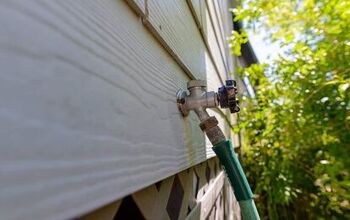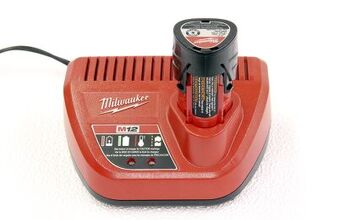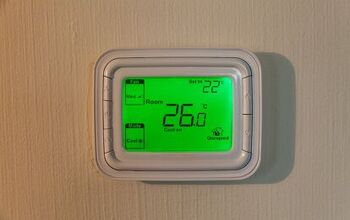Why Are There Still Roaches After Extermination?

The sight of cockroaches in your house is enough to make your stomach turn. They’re equally ugly, inconvenient, and loud, and that’s why many people call exterminators right away. However, you may still see roaches in your house even after an extermination.
Roaches can still appear if eggs hatch after an exterminator has sprayed your house. You may also find roaches if your p-traps are dry, as they can crawl up your pipes from the sewer system. New roaches can also enter your home through door gaps and cracks in your exterior walls and windows.
It’s worth buying weatherstripping and caulk to patch these gaps, so you can keep roaches out. Follow along as we explore why roaches still appear in your home after an extermination.
Why Am I Still Seeing Roaches After Extermination?
You most likely still see roaches after an extermination because the insecticides haven’t kicked in yet. This is a tough pill to swallow if you were expecting the roaches in your home to disappear right away. However, the reasons why can differ based on how the roaches got into your home and where they’re hiding.
The problem with cockroach extermination is that roaches can hide in many hard-to-reach crevices. Because of that, even the most thorough exterminator may struggle to treat every inch of your home with insecticides.
That is, of course, unless you declutter and expose every potential roach hiding spot in your home. Here are some reasons roaches can still appear in your home after an extermination.
1. It Gets Worse Before It Gets Better
As annoying as it sounds, sometimes, your roach problem will get worse before it gets better. You may notice more cockroaches in your home after the extermination. However, the reality is, you probably have the same number of roaches, but they’ve emerged from hiding spots.
This is normal, as the chemicals exterminators use typically drive roaches and other pests into plain sight. The insects may become especially desperate and show up in common areas of your home where you didn’t see them before.
Luckily, this should only last for a few days before you start seeing the roaches die. By moving around your house, they will likely further expose themselves to the chemicals, ensuring they work. That said, it's normal to feel nervous upon seeing this after an extermination.
2. Eggs Hatching
Cockroaches can lay anywhere from 15 to 50 eggs at a time, depending on the species. Because of this, badly infested homes sometimes have dozens of hidden cockroach eggs at any time. Often, cockroaches lay their eggs in hard-to-reach areas, and exterminators may not spray these spots.
Because of that, some eggs may still hatch after extermination, since they weren’t affected. Depending on the timeline, the baby cockroaches may die after venturing out into your home. However, that won’t likely happen if it’s been several days and the chemicals have dried up.
In that case, you may unfortunately need to call the exterminator again. That said, you can potentially get them under control using diatomaceous earth, glue traps, and bait stations. This is easier if there’s only a small handful of baby roaches, and killing them early is key.
3. The Roaches Are Resistant
Cockroaches are among the most resilient pests in the world. Killing them is sometimes easier said than done, even if you’re an experienced exterminator. That’s because cockroaches can develop a resistance to certain insecticides, which can explain why you still see them after your home has been sprayed.
The problem has worsened, but reports of insecticide-resistant cockroaches go back to the 1950s. This is ultimately why exterminators use many methods at the same time to get rid of roaches. Unfortunately, exterminators cannot guarantee that chemical treatments alone will work.
German roaches, which are found in the U.S., are especially resistant to some insecticides. Many people fear that this resistance will only strengthen with time, so you must be patient with your exterminator.
4. Easy Entry Points
Spraying your house for roaches is essentially useless if there are still many entry points. Door gaps, window cracks, and exterior wall damage make it easy for roaches to enter a home. Insecticides can kill existing roaches, but they won’t stop them from entering your home.
You must patch the cracks and holes in your exterior walls to keep roaches out of your house. It’s also worth installing weatherstripping at the bottom of your doors to deter roaches. Weatherstripping is cheap, easy to install, and can also help keep cool air in and hot air out during the summer.
If you can’t do this right away, it’s at least worth setting traps near common roach entry points. For example, you can place glue traps along the walls and in the corners of rooms near their entry points. Otherwise, it’s best to seal gaps and cracks with caulk and weatherstripping.
5. You Reintroduced Them
In many ways, cockroaches are hitchhikers, as they can hitch a ride and sneakily enter your home. This is true even after extermination, as the new roaches weren’t exposed to any insecticides before entering your house. Unfortunately, roaches can hitch a ride on groceries, packages, secondhand furniture, thrifted clothing, and more.
This may even be how roaches got into your house in the first place, so reintroducing them isn’t too big a leap. You may also repeatedly find roaches at home if you live right behind or next to a busy restaurant. That’s especially true in cities, where cockroach populations are often dense and people live close to each other.
The good news is that you can likely get the problem under control if there are only a few roaches. For one thing, the insecticides may still be active, which means they may kill the new roaches. Otherwise, you can either manually kill the new roaches or trap them with glue traps.
6. Plumbing Problems
Nobody wants to deal with plumbing problems and roaches simultaneously, but it may be necessary. That’s because roaches can keep entering your home after extermination if they come in through your plumbing fixtures. For example, cockroaches can easily crawl up your drains if the P-traps are dry.
Pipe leaks and dripping faucets can also attract cockroaches, who are looking for moisture. It’s also important to keep a humidity monitor at home and run a dehumidifier if the level exceeds 50%-60%. Of course, you must also avoid putting food scraps down your kitchen sink drain.
Even crumbs and other food messes on the counters near your plumbing fixtures can attract roaches. You can’t control the roaches in the sewer system that your house is connected to, but patching pipe cracks and leaks can help keep them out of your home.
7. You Haven’t Waited Long Enough
If you expected the exterminator’s treatment to work right away, you may be in for a disappointment. You may not notice a huge difference in roach activity at home until a few weeks after the treatment. Some insecticides take weeks to kill all the cockroaches in a house, so the chemical itself plays a big role in the timeline.
You must also consider that some of the roaches in your house may be resistant to insecticide, whereas others are vulnerable to it. In general, it’s a good idea to ask the exterminator about what you should expect after treatment.
That way, you won’t be surprised if it’s been a week and you still see some roaches at home. Be patient, as it takes time.
Summing It Up
You may still see roaches for a few weeks after an extermination, as insecticides don’t always work immediately. There’s also a good chance that some eggs hatched after the extermination, and that’s why you see roaches again. Otherwise, roaches can still enter your home through cracks and gaps in the walls and plumbing, so you must patch them.
Related Guides:

Nick Durante is a professional writer with a primary focus on home improvement. When he is not writing about home improvement or taking on projects around the house, he likes to read and create art. He is always looking towards the newest trends in home improvement.
More by Nick Durante













![10 Best Electric Pressure Washers – [2022 Reviews & Guide]](https://cdn-fastly.upgradedhome.com/media/2023/07/31/9070600/10-best-electric-pressure-washers-2022-reviews-guide.jpg?size=350x220)













